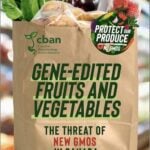One Green Planet | Mathew Davis | July, 2024
Ever wonder how herbicides make their way into your meals? Let’s dive into the basics. A herbicide is a chemical substance used to control or destroy unwanted vegetation, particularly weeds.
Farmers and gardeners widely use these chemicals to ensure crops grow just right. But, here’s the kicker – while herbicides help crops thrive, residues of these chemicals can end up in the foods we eat.
So, how does this happen? Here are the main ways herbicides sneak into your food:
- Direct Application: Herbicides are sprayed directly onto crops to eliminate weeds, leaving chemical residues on the produce.
- Drift Contamination: These chemicals can drift from the target area to nearby fields, contaminating other crops.
- Soil Absorption: Herbicides can remain in the soil and be absorbed by plants during their growth.
- Water Runoff: They can also enter water supplies through runoff, potentially being taken up by plants irrigated with contaminated water.
Understanding these pathways highlights the importance of monitoring and regulating herbicide use to ensure the safety of our food.
To make informed choices, it’s crucial to understand which herbicides are most common, where they lurk, and what risks they pose. Here, we’ve curated a list of 10 herbicides that frequently show up in our foods, along with the potential dangers of consuming them.
Dr. Eric Berg DC | YouTube
1. Glyphosate
Glyphosate is one of the most widely used herbicides globally, found in products like Quaker Oats and General Mills cereals. Despite studies by the EPA indicating no immediate risk, concerns persist about long-term exposure and its potential carcinogenic effects.
The herbicide works by targeting and inhibiting an enzyme essential for plant growth, effectively eliminating weeds and other undesired vegetation. However, ongoing debates about its safety continue, largely due to potential health risks linked with its active ingredient.
Foods Containing Glyphosate: It’s not just cereal; glyphosate residues can be found in a range of food products. These include soybeans, corn, and a variety of fruits and vegetables. Given its widespread agricultural use, it’s challenging to avoid completely.
Potential Dangers: While the EPA dismisses immediate toxicity, several studies suggest a correlation between glyphosate exposure and certain health issues. The International Agency for Research on Cancer (IARC) has classified glyphosate as “carcinogenic to humans,” intensifying the controversy. Long-term exposure has been potentially linked to non-Hodgkin lymphoma and other health concerns.
An important step you can take is to stay informed and make conscious food choices. Opting for organic produce and checking product labels can help minimize your glyphosate exposure.
2. Atrazine
Atrazine is another herbicide primarily used on corn crops. You can find its residues in foods such as corn chips and popcorn. Prolonged exposure has been linked to hormone disruption and reproductive health issues. Despite its efficacy, atrazine’s presence in commonly consumed foods makes it a point of concern.
Besides corn chips and popcorn, traces can also be found in some breakfast cereals and tortillas. To stay on the safer side, you might consider purchasing organic versions of these foods, as they are less likely to contain herbicide residues.
Dangers of Atrazine Consumption: Long-term exposure to atrazine can be more worrisome. Studies have highlighted potential health risks, including hormone disruption and developmental issues. If you’re pregnant or planning to conceive, minimizing your intake of foods likely to contain this herbicide is especially important.
While complete avoidance may be difficult, being informed can guide you to make better choices for your health.
- Look for organic labels on corn-based products.
- Stay updated on food safety reports that track herbicide residues.
- Consider growing your corn if you have the space and time.
3. Dicamba
Used mainly on soybeans, Dicamba can drift from treated locations, affecting other plants. Foods likely to contain Dicamba residues include soy products. Its toxicity can lead to skin irritation and potential respiratory issues. Moreover, studies have shown that Dicamba’s volatility can spread its impact far and wide. This herbicide’s presence isn’t limited to fields. Dicamba residues can end up in everyday products like soy milk, tofu, and even certain processed foods.
Long-term exposure remains a concern. Beyond immediate skin and respiratory issues, the chronic ingestion of Dicamba residues is still a topic of ongoing research. Regulatory bodies have set limits on Dicamba residues to mitigate potential health risks, but it’s crucial to stay informed.
Concerned about Dicamba in your diet? Washing produce thoroughly and opting for organically-grown soy products can help reduce your exposure. It’s an excellent step towards ensuring what you eat is as safe and healthy as possible.
4. 2,4-D
Often found in cereals and bread, 2,4-D has a history dating back to its use in Agent Orange. It has been associated with potential liver damage and hormonal disruptions. As one of the most commonly used herbicides worldwide, 2,4-D is often detected in various fruits and vegetables. While its efficacy in controlling weeds is notable, the real concern lies in its residue levels in our food supply.
Studies have indicated that exposure to 2,4-D can lead to various health issues. This includes Liver Damage: Long-term exposure has been linked to liver toxicity, potentially causing chronic liver diseases, Hormonal Disruptions: 2,4-D can interfere with the endocrine system, leading to disruptions in hormone levels, which might affect growth, metabolism, and reproduction and Respiratory Issues: Workers and individuals near sprayed areas might experience respiratory distress or irritation.
Due to its widespread use, traces of 2,4-D can be found in Grains: Such as wheat and oats, commonly used in breakfast cereals and bread, and Fruits:Including apples, cherries, and grapes. And Vegetables: Particularly root vegetables like carrots and potatoes.
To minimize the risks associated with 2,4-D, consider taking these steps: Wash Your Produce: Thoroughly washing fruits and vegetables can help remove some pesticide residues, Opt for Organic: Choosing organic produce can significantly reduce your exposure to 2,4-D and Stay Informed: Staying updated on pesticide regulations and safety reviews can help you make informed decisions about your food choices.
Dr. Livingood | Youtube
5. Paraquat
Paraquat is an herbicide used on crops such as cotton and potatoes. Consuming even small amounts has been linked to a higher risk of Parkinson’s disease and lung damage. Moreover, paraquat is highly toxic if ingested, and has been a serious cause of concern among health experts.
Given its high toxicity, many countries have restricted or banned its use. However, in regions where paraquat use is still prevalent, the risks remain significant. Accidental ingestion, often due to improper handling, can lead to fatal poisoning. Even minimal exposure over time can contribute to chronic health issues.
Foods commonly exposed to paraquat: Before reaching your plate, crops such as corn, soybeans, and various types of fruits and vegetables may be treated with paraquat. While these foods are washed and processed, residues can remain, leading to potential consumption over time.
Dangers of consuming paraquat: This herbicide is not just harmful upon direct contact or inhalation; consuming food with paraquat residues poses substantial health risks. Research links paraquat exposure to long-term health issues including kidney failure, developmental and reproductive harm, and immune system suppression.
To minimize your risk, consider opting for organic produce where possible, as organic farming prohibits the use of paraquat and other harmful synthetic herbicides. Additionally, thoroughly washing fresh produce can help reduce residue levels, though it may not eliminate the risks.
6. Atrazine
Although already mentioned, it’s worth noting Atrazine again due to its widespread use and the multiple foods it can affect, including juices and wheat products. It is a known endocrine disruptor. Given its ability to mimic hormones, Atrazine can lead to severe reproductive issues in both wildlife and humans.
Foods affected by Atrazine aren’t limited to the obvious suspects like corn and cereal grains. Remarkably, juices and even wine may carry traces due to their ingredients and production processes. Consuming such contaminated products might expose you to the risk of developmental and endocrine health complications. Thus, choosing organic options, where Atrazine usage is restricted, may be a safer bet.
Are there any solutions? Regulatory organizations continue to re-evaluate the safety guidelines for Atrazine use. While waiting for stricter controls, consider supporting local farmers and producers who boast Atrazine-free practices. Their dedication to sustainable farming is not just good for your health but also for the environment.
7. Glufosinate
Similar to Glyphosate in its application, Glufosinate is commonly used on genetically modified crops. It appears in foods like canola oil and Glufosinate is not only effective but also quite pervasive in our food systems.
By inhibiting glutamine synthetase, it hinders plant growth, making it a go-to for keeping crops weed-free. It’s interesting to note that while it’s a savior for many farmers, it poses certain risks.
Where is it found? You’ll mainly find traces of Glufosinate in canola oil, corn, and a variety of soybean products. These foods are staples in many households, meaning exposure can be frequent, though in very small doses.
Health Concerns: What should you be cautious about? Neurotoxicity is a primary concern. Studies suggest that prolonged exposure might affect brain function, particularly in developing children. Aside from this, there’s also the potential for developmental delays and reproductive issues.
What’s the takeaway? Awareness is crucial. While the herbicide helps ensure a stable food supply by keeping weed competition at bay, like with anything, moderation and caution are key. Opt for organic and non-GMO labeled products when possible to minimize exposure. Remember, being informed is your first defense.
8. Metolachlor
This herbicide is primarily used on crops like corn and soybeans. Found in various corn-based foods, it has potential carcinogenic effects and can impact the liver and kidneys. The widespread use of glyphosate means that residues can often be found in everyday foods like cereals, bread, and even oats.
Research indicates that glyphosate may be linked to the development of various cancers and long-term organ damage, particularly affecting the liverand kidneys. Its potential role in endocrine disruption is also a growing concern.
Glyphosate is favored in agriculture due to its effectiveness in controlling a broad spectrum of weeds and grasses. Its use extends beyond just crop production; it’s also applied in orchards, vineyards, and even for invasive species control in natural habitats. This prolific use has raised ecological concerns, impacting both the environment and non-target plant species.
To minimize your exposure to glyphosate, consider purchasing organic produce whenever possible. Washing fruits and vegetables thoroughly can also reduce residue levels, although it may not eliminate them.
9. Pendimethalin
Pendimethalin residues can be found in foods such as spinach and carrots. Though less commonly discussed, it has been linked to possible liver and thyroid toxicity. Additionally, pendimethalin is prevalent in many soil treatments for crops like beans and corn. Its residues can easily make their way into the foods on your table.
Potential Dangers: There are concerns about pendimethalin’s impact on human health. High exposure levels may lead to liver and thyroid dysfunction, with some studies suggesting potential carcinogenic effects over prolonged periods. While regulatory bodies emphasize that the amounts found in foods are within safe limits, it’s still a herbicide worth keeping an eye on.
To minimize exposure, thoroughly wash produce and consider buying organic varieties whenever possible. Incorporating these small steps can help reduce the potential risks associated with pendimethalin residue in your diet.
10. Trifluralin
Used primarily on vegetable crops, residues of Trifluralin can be found in foods like broccoli and green beans. It has the potential to disrupt thyroid functions and impact liver health. Although commonly used, this herbicide’s impacts remain subject to ongoing research and debate.
Significant concerns have emerged regarding its use and potential health implications. Trifluralin has been linked to harm to aquatic life, posing environmental risks. The EPA categorizes it as a possible human carcinogen, meaning there’s a potential for it to contribute to cancer development over long-term exposure.
Conclusion
It’s crucial to be mindful when shopping for vegetables. Opt for organic produce when possible to minimize exposure. If you can’t go fully organic, making sure to adequately wash and peel the items can help reduce the risk of ingesting these residues.
Overall, staying informed and making conscious choices in your diet can significantly impact your overall well-being. While the residues might be minimal, the cumulative effect warrants attention.
Understanding these herbicides and their potential risks is the first step toward making informed dietary choices. By arming yourself with this knowledge, you can better navigate the complex landscape of modern food production.
Originally published on One Green Planet, please click here to read more.







